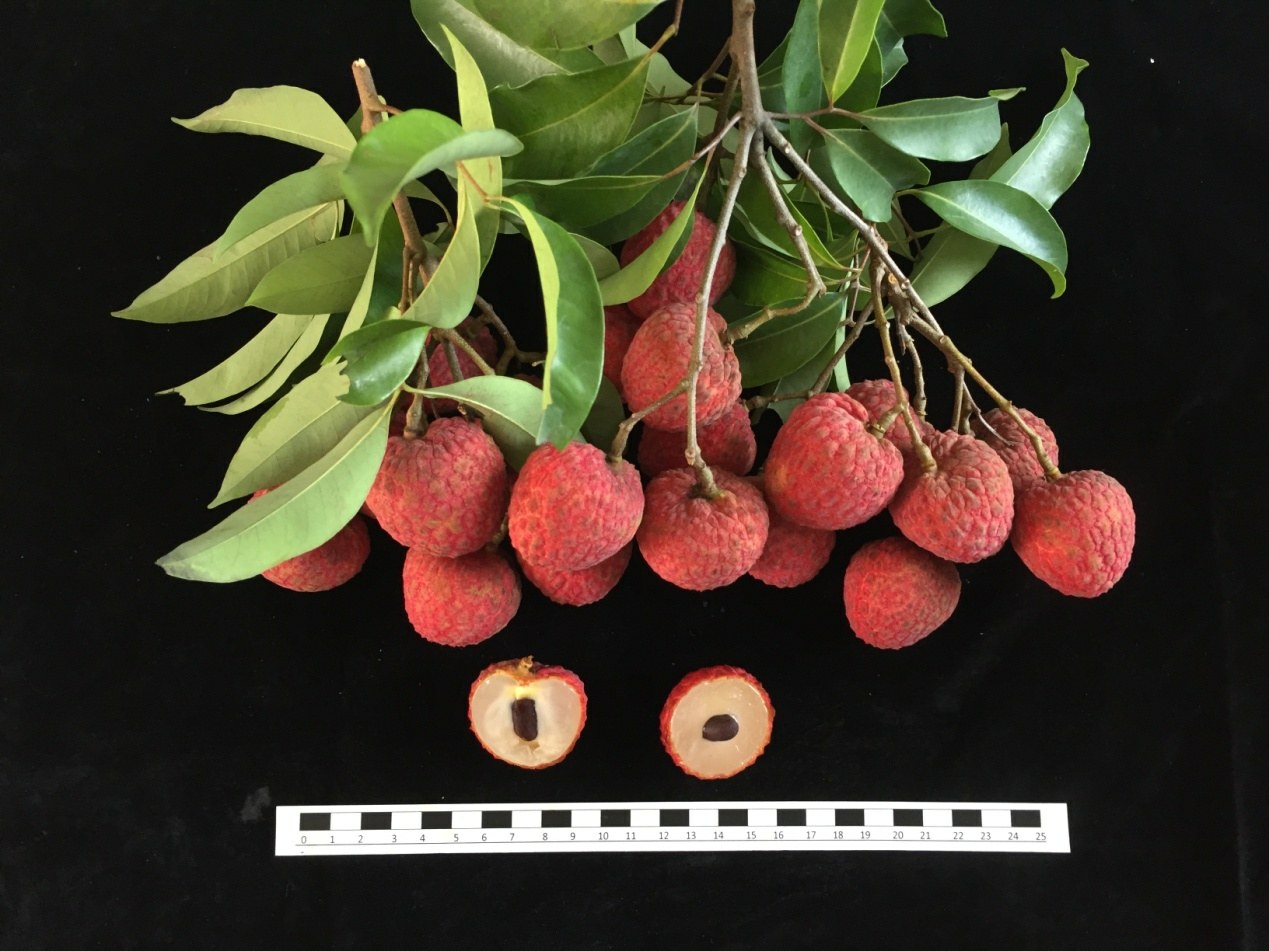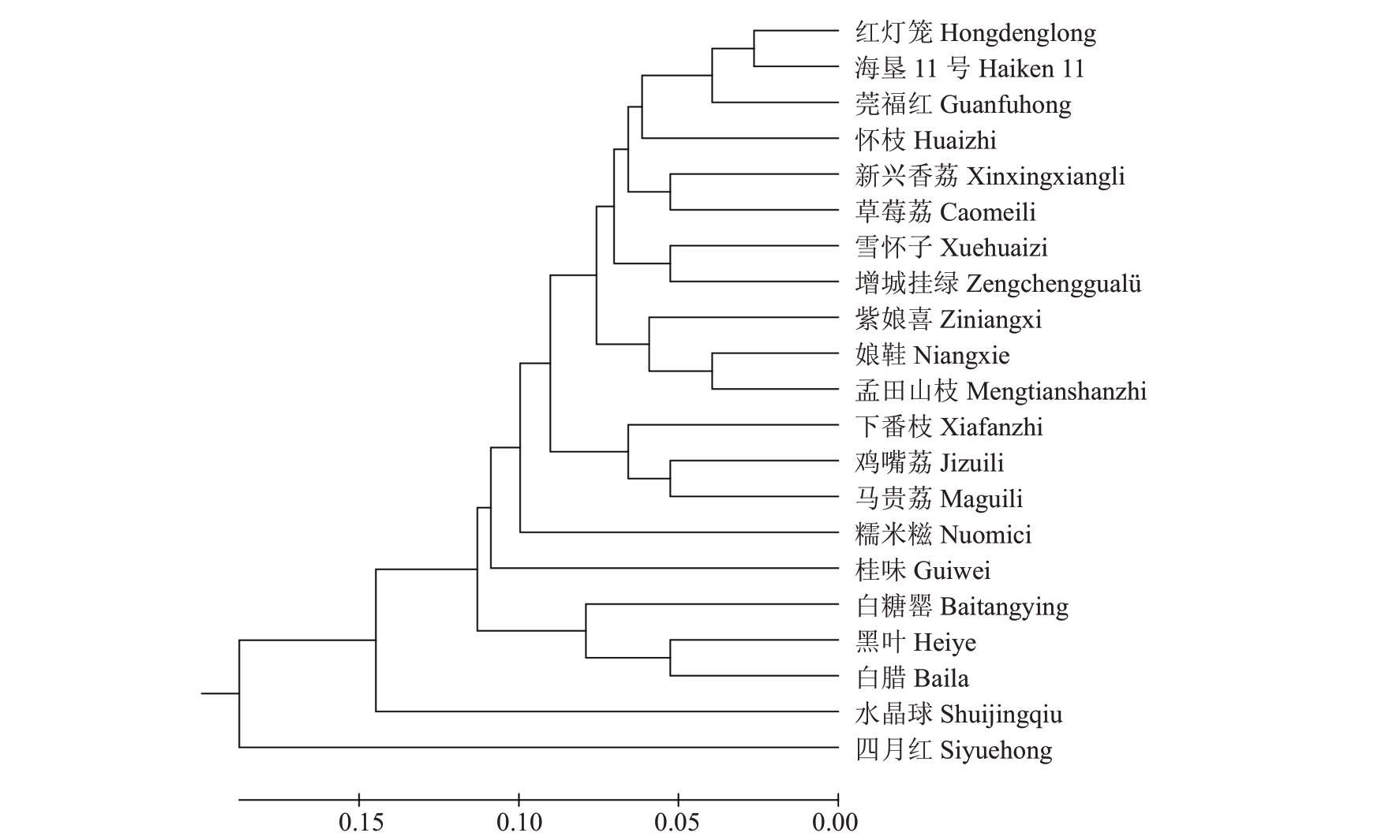荔枝原产于中国,是典型的亚热带常绿果树,我国有2000多年的荔枝栽培历史,是世界荔枝种质资源最丰富、品种最多的国家之一[1],广东荔枝则以优良品种众多,果实色、香、味兼具而闻名国内外。广东现有荔枝种植面积26 万hm2,年均产量120 万~150 万t,种植面积和产量分别占全国的46%和60%以上[2]。但粤中晚熟荔枝产区主栽品种以糯米糍、桂味为主,产期集中,市场销售压力过大,因此选育晚熟、优质的荔枝品种是荔枝产业高质量发展的重要任务。
1 选育过程
莞福红荔枝是采用实生选种的方法选育出的晚熟荔枝新品种(图1),其母树位于东莞市厚街镇大迳社区。该果场建于1985 年,从外地引入桂味、糯米糍、妃子笑等荔枝嫁接苗进行种植,1993 年园主发现一株果实较大、果皮鲜红色,外观像糯米糍的荔枝,但果实风味不同于糯米糍荔枝,且成熟期比糯米糍晚。从2013 年起,笔者开始对该优株进行调查,并在东莞市厚街镇、东莞市农业科学研究中心荔枝试验基地开展多点比较试验。结果表明,该优株各世代遗传性状稳定;高接换种后第3 年就可开花结果,第4 年即可投产,早结丰产。2022 年11 月获得植物新品种权,品种权号:CNA20191006492。
2 主要性状
2.1 植物学特征
莞福红品种树势中等,树冠半球形,树干灰褐色。小叶2~3 对,叶片披针形,叶色浓绿,先端渐尖,叶缘平直,少数呈微波浪形,叶片长16.7 cm、宽3.9 cm。花序形状为圆锥形,花序主轴平均长26.1 cm、宽13.9 cm。花朵大小中等,花柱开裂程度中等。
2.2 生物学特性
2.2.1 枝梢生长特性 幼年树每年可抽梢5~6 次,通常春梢1次,2月中旬至3月上旬萌发;夏梢2次,5月上旬至7 月下旬萌发;秋梢2 次,7 月底至10 月抽出,壮、旺树能萌发3次;冬梢1次或无,11月至翌年1月抽出。成年结果树采果后可萌发2~3次梢。
2.2.2 开花结果习性 莞福红一般1 月下旬至2 月上旬出现“白点”,2月中旬抽出花穗,3月底至4月初为始花期,4 月上中旬谢花,4 月中下旬第一次生理落果,5月上旬第二次生理落果,5月下旬至6月上旬第三次生理落果,6 月初果实着色,果实成熟期在6月下旬至7月上旬。
2.3 果实性状
果实心形,果皮鲜红色,龟裂片隆起,裂片峰钝圆;果实平均单果质量29.3 g,可食率78.8%,可溶性固形物含量(w,后同)19.6%,总糖含量17.6%,可滴定酸含量1.09%,维生素C 含量264.0 mg·kg-1(表1),比糯米糍迟熟7~10 d。
表1 莞福红和糯米糍果实性状比较
Table 1 Comparison of fruit economic characters between Guanfuhong and Nuomici

品种Cultivar莞福红Guanfuhong糯米糍Nuomici果形Fruit shape心形Heard-shaped心形Heard-shaped单果质量Single fruit mass/g w(可溶性固形物)Soluble solids content/%w(总糖)Total sugar content/%w(可滴定酸)Titratable acid content/%w(维生素C)Vitamin C content/(mg·kg-1)可食率Edible rate/%29.3 24.2 19.6 19.0 17.6 17.9 1.09 1.60 264.0 331.0 78.8 78.4
3 分子标记鉴定
笔者团队委托广东省农业科学院果树研究所开展分子标记鉴定[3-4],选用筛选出来的19对扩增效率高、分型效果明显的SNP 引物,利用这些引物对莞福红荔枝与现有的390份荔枝种质进行亲缘关系分析。结果表明,19 对SNP 引物均表现为二等位性,莞福红与现有390 份荔枝种质的遗传距离介于0.053~0.816 之间,可见莞福红为新的荔枝种质(图2)。
4 栽培技术要点
4.1 建园
选择背风向阳、土壤肥力充足、保水保肥力强、排水防涝良好的地块建园。种植穴深度0.8~1.0 m,直径0.6~0.8 m,在定植前1~2个月施足基肥,并于春季栽植;种植密度为6 m×8 m;间种绿肥或良性杂草。
4.2 整形修剪
幼年树定干高度30~40 cm,培养分布均匀的3~4个主枝。成年结果树主要在采果后和出现“白点”后进行修剪。采果后以疏剪和回缩为主,主要疏除或重回缩树冠中外部过高或过旺的大枝和过密枝,形成开心形通风透光的树形。出现“白点”后以疏剪为主,剪除过密枝、荫蔽枝、弱枝、病虫枝等。
4.3 水肥管理
幼龄期及新梢生长时期,偏施氮肥。结果树全年要施肥3 次:开花肥、壮果肥和秋梢肥,有机肥与无机肥结合施用效果最佳。果实发育期和秋梢生长期可结合树势情况补充施肥。花芽分化期要求干燥的环境,末次秋梢中后期不要淋水施肥,保持土壤干燥,大约在花芽萌动时开始灌水,以提高成花率。
4.4 控梢促花
一般培养2 次健壮秋梢,以11 月中下旬充分老熟的末次秋梢作为翌年的结果母枝为宜。末次秋梢老熟后,于11月底或12月初在主枝上进行闭口环割一圈,深达木质部,抑制冬梢萌发;如有冬梢萌出,在冬梢展叶前喷施0.03%~0.04%的乙烯利。
4.5 病虫害防治
莞福红的主要病虫害有荔枝蝽、蒂蛀虫、尺蠖、霜疫霉病、炭疽病等。梢期注意防治食叶类害虫,挂果期注意防治荔枝蝽、蒂蛀虫。防治时应根据病虫害的发生时期,做到预防为主,综合防治。另外,果实成熟期间要注意防止鸟类啄食。
参考文献References:
[1] 李建国.荔枝学[M].北京:中国农业出版社,2008:106-122.LⅠJianguo.The litchi[M].Beijing:China Agriculture Press,2008:106-122.
[2] 郭栋梁,黄石连,向旭.2022 年广东荔枝生产形势分析[J].广东农业科学,2022,49(6):130-137.GUO Dongliang,HUANG Shilian,XⅠANG Xu.Analysis of Guangdong Litchi production situation in 2022[J].Guangdong Agricultural Sciences,2022,49(6):130-137.
[3] 赵俊生,刘伟,钟声,曾运有,冯声海,向旭.荔枝优良新品种‘翡脆’的选育[J].果树学报,2018,35(2):261-264.ZHAO Junsheng,LⅠU Wei,ZHONG Sheng,ZENG Yunyou,FENG Shenghai,XⅠANG Xu.Breeding of a new high quality litchi cultivar‘Feicui’[J].Journal of Fruit Science,2018,35(2):261-264.
[4] 刘伟,廖美敬,蒋侬辉,凡超,吴颜洲,张湛辉,朱润尧,向旭.荔枝新品种‘北园绿’的选育[J].果树学报,2019,36(2):253-255.LⅠU Wei,LⅠAO Meijing,JⅠANG Nonghui,FAN Chao,WU Yanzhou,ZHANG Zhanhui,ZHU Runyao,XⅠANG Xu.Breeding of a new litchi cultivar‘Beiyuanlü’[J].Journal of Fruit Science,2019,36(2):253-255.
Selection of a new late-maturing litchi cultivar Guanfuhong
MA Ke1,WANG Yan1,HU Shan1,ZHANG Ruiping2,LAⅠYongchao1,LⅠJiaqiang1,LⅠJianguo3*
(1Dongguan Agricultural Scientific Research Center, Dongguan 523086, Guangdong, China;2Houjie Town Agricultural Technology Service Center, Dongguan 523900, Guangdong, China;3College of Horticulture, South China Agricultural University, Guangzhou 510642,Guangdong,China)
Abstract: Guanfuhong, a new litchi cultivar with excellent characteristics, was selected through the seedling selection.Ⅰn 1993, maternal tree of Guanfuhong was initially selected for its large fruit size, a high and steady yield, a bright red pericarp, excellent quality, late-marurity and high quality in Dongguan city,Guangdong province.After many-year regional trials,it was found that the genetic characteristic was stable.The new plant variety right was obtained in January 2023.The cultivar is a tall tree,with spreading growth habit and semi-circular canopy shape.Leaves are lanceolate, 16.7 cm long and 3.9 cm wide.Ⅰnflorescence is conical;the main axis of inflorescence is 26.1 cm long and 13.9 cm wide.Flower is white with medium size.Guanfuhong can sprout new shoots all round the year, with young shoots growing about 5-6 times, while with fruiting trees they grow about 3-4 times.Fruit is mainly heart-shaped and the peel is red.The flesh is white with sweet flavor and aroma.The average fruit weight is 29.3 g; the horizontal diameter of fruit is 40.70 mm, the longitudinal diameter of fruit is 39.35 mm,and the number of seed is 1.The eatable rate of fruit is 78.8%.The soluble solids content is 19.6%and soluble acid is 1.09%.The content of vitamin C is 264.0 mg·kg-1.The fruit quality of Guanfuhong is excellent.The fruit development period is about 80 d.And its maturity period is from late June to early July in Dongguan city, Guangdong province.Ⅰt is resistant to both drought and water logging.The grafting compatibility between Guanfuhong and Huaizhi, Guiwei or Nuomici is high.Ⅰn the third year after high-grafting, this cultivar can bear fruits, and the yield potential is high.The orchard should be established on acid red loam soil, which has good ability of moisture and fertilizer retention.Spacing in the rows and between rows is 6 m×8 m.The trunk is 0.3-0.4 m high with 3-4 main scaffold limbs, which are uniformly distributed with good growth vigor.Pruning should be carried out immediately after fruit picking with adult fruiting trees.The main method is thinning and heading back, to remove or retract the large and dense branches that are too high or too dense to form an open-center shape for desirable ventilation and light transmission.After the occurrence of'white spots',the main method is thinning, and the dense, shady, weak as well as diseased and insect branches should be cut off.Winter shoot should be controlled by girdling or spraying paclobutrazol or uniconazole,which aims to promote flower differentiation.Flowers and fruits need to be thinned adequately when the rate of flowers and fruit set is excessive.Ⅰt is advisable to apply enough base fertilizer to guarantee proper growth and development.Ⅰn addition, it is very important to prevent and control pests and diseases such anthracnose,stem borers,litchi stink bugs and downy mildew.Due to the lengthy fruiting period,it is recommended to apply organic fertilizer before flowering and spray foliar fertilizer during the young fruit stage to ensure the normal growth of flowers and fruits.Guanfuhong has a strong adaptability and the suitable cultivation area includes the majority of the mid-late maturing litchi production areas in Guangdong province.
Key words:Litchi;New cultivar;Guanfuhong;Late-maturing


